It’s been a shark
infested week with lots of sightings, black tip reef sharks, white tip reef
sharks, grey reefs and nurse sharks. I am not complaining! Sharks are
definitely one of my most favourite marine animals so I thought it was about
time I blogged about these awesome predators…
Why is it we have such
a fear about sharks? When I was younger I was also scared to death of sharks.
The movie Jaws did not help! My fear for the unknown led to a fascination… I
was hooked! I wanted to learn everything about sharks and gain a deeper
understanding of the thing that frightened me the most. Not a bad thing really,
as ultimately as a result, I fell in love with the oceans, which is why I
became a Marine Biologist.
I love seeing sharks in
their natural habitat, swimming with them is so captivating, they are so
graceful and mysterious, but unfortunately not everyone feels the same way as
me. In today’s world when you think of shark, one image comes to mind more
often than any other…. “Jaws”, a vicious, man-eating, indiscriminate killer.
The media does not help, in fact their stereotypic characterisation of sharks
are full of misinformation. They portray sharks as monsters of the deep, but
this is the myth not the reality, a reputation which is widespread but hardly
deserved.
Sharks are one of the
oldest living things on earth. They have been here for over 400 million years,
150 million years before the dinosaurs. Throughout this time they have
remain unchanged and are still the top predators in the oceans: the lions and
tigers of the seas. Sharks are vital for maintaining a healthy balance of life
in the oceans. They feed on the sick and dying, and on the larger animals such
as the whales, seals and tuna, which have few predators. The oceans remain
healthy because every organism in it is part of a complex food web. If sharks
were removed then it could be disastrous to the ocean ecosystem. So believe it
or not, we need sharks in our oceans.
Statistically, the
chances of being attacked by a shark are tiny (about 1 in 11.5 million). In
2012, there were only 80 shark attacks worldwide, 7 of which were fatal. The
fact is, you are more likely to be hit by a car or even struck by lightning
than you are to be attacked by a shark. Elephants, crocodiles, even defective
toasters kill more people each year than sharks!! Considering how many millions
of people use the oceans everyday, and the few attacks that occur every year,
is an excellent indication that sharks do not eat people. Most attacks are
simply accidental or a case of mistaken identity whereby sharks confuse surfers
for prey like seals or turtles.
Sharks, however, need
our help. While they kill fewer than 10 people a year, their own numbers suffer
greatly at human hands. Scientists estimate that worldwide up to 100 million
sharks are killed every year and as a result 50 species are listed as vulnerable
or in danger of extinction. One reason that shark populations have declined so
rapidly is that many common fishing methods accidentally capture sharks in
addition to the targeted fish. Long lines and gill nets are the most
destructive. Every year they are responsible for killing millions of sea
creatures, which are needlessly drowned in these lines and nets. Not just
sharks, but rays, whales, dolphins, albatrosses and sea turtles are also
affected This is less of an issue in the Maldives as net fishing is illegal but
unfortunately they are used in many parts of the world.
What’s even worse is
that sharks are now directly targeted by fishermen, who kill them just for
their fins!!! The fins are used to make shark fin soup which is a very
traditional dish to eat in China and Asia. It is a symbol of wealth and served
as a sign of respect, but unfortunately this delicacy is responsible for
decimating shark population all over the world. Fins can fetch more than 450
US$ per pound which makes sharks hot targets for fisherman. Its also very
cruel, the fins are often sliced off while the shark is still alive and then
the body of the shark is wastefully dumped back into the sea for a slow and
painful death. As sharks are slow growing and reproduce at a slow rate their
populations cannot handle this high demand from the shark fin trade, with
some species on the brink of extinction!!!


















































